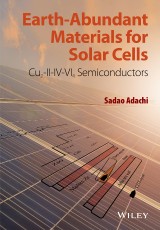Details

Earth-Abundant Materials for Solar Cells
Cu2-II-IV-VI4 Semiconductors1. Aufl.
|
136,99 € |
|
| Verlag: | Wiley |
| Format: | |
| Veröffentl.: | 28.10.2015 |
| ISBN/EAN: | 9781119052838 |
| Sprache: | englisch |
| Anzahl Seiten: | 480 |
DRM-geschütztes eBook, Sie benötigen z.B. Adobe Digital Editions und eine Adobe ID zum Lesen.
Beschreibungen
<p>Systematically describes the physical and materials properties of copper-based quaternary chalcogenide semiconductor materials, enabling their potential for photovoltaic device applications.</p> <p>Intended for scientists and engineers, in particular, in the fields of multinary semiconductor physics and a variety of photovoltaic and optoelectronic devices.</p>
<p>Preface ix</p> <p>Abbreviations and Acronyms xi</p> <p><b>1 Introduction</b> <b>1</b></p> <p>1.1 Natural Abundance of Elements in the Earth’s Crust 1</p> <p>1.1.1 Chemical Elements 1</p> <p>1.1.2 Solar Cells and Earth-Abundant Materials 4</p> <p>1.2 Solar Radiation Spectrum 5</p> <p>1.3 Shockley–Queisser Efficiency Limit 6</p> <p>1.4 Fundamental Properties of Photovoltaic Semiconductor Materials 8</p> <p>1.5 Solar Cell Device Characteristics 11</p> <p>1.6 Prediction of Physical Properties for Complex Material System 13</p> <p>1.6.1 An Effective Medium Approximation 13</p> <p>1.6.2 An Interpolation Scheme 15</p> <p>References 19</p> <p><b>2 Structural Properties</b> <b>21</b></p> <p>2.1 Grimm–Sommerfeld Rule 21</p> <p>2.2 Crystal Structure and Phase Stability 22</p> <p>2.2.1 Crystal Structure 22</p> <p>2.2.2 Theoretical Phase Stability 24</p> <p>2.3 Lattice Constant and Related Parameters 25</p> <p>2.3.1 Bulk Material 25</p> <p>2.3.2 Nanocrystalline Material 52</p> <p>2.4 Structural Phase Transition 58</p> <p>References 61</p> <p><b>3 Thermal Properties</b> <b>67</b></p> <p>3.1 Phase Diagram 67</p> <p>3.1.1 Cu<sub>2</sub>Zn–IV–VI<sub>4</sub> Quaternary 67</p> <p>3.1.2 Cu<sub>2</sub>Cd–IV–VI<sub>4</sub> Quaternary 72</p> <p>3.1.3 Cu<sub>2</sub>Hg–IV–VI<sub>4</sub> Quaternary 75</p> <p>3.1.4 Cu<sub>2</sub>–II–IV–VI<sub>4</sub> Solid Solution 78</p> <p>3.2 Melting Point 81</p> <p>3.3 Specific Heat 86</p> <p>3.4 Debye Temperature 88</p> <p>3.5 Thermal Expansion Coefficient 89</p> <p>3.6 Thermal Conductivity 92</p> <p>3.6.1 Quaternary Material 92</p> <p>3.6.2 Alloy Material 101</p> <p>3.7 Thermal Diffusivity 107</p> <p>References 107</p> <p><b>4 Elastic, Mechanical, and Lattice Dynamic Properties</b> <b>111</b></p> <p>4.1 Elastic Constant 111</p> <p>4.1.1 General Remark 111</p> <p>4.1.2 Theoretical Value 113</p> <p>4.1.3 Young’s Modulus, Poisson’s Ratio, and Similar 115</p> <p>4.1.4 Sound Velocity 118</p> <p>4.2 Microhardness 121</p> <p>4.3 Lattice Dynamic Properties 124</p> <p>4.3.1 Phonon Dispersion Relation 124</p> <p>4.3.2 Raman Scattering: Tetragonal Lattice 126</p> <p>4.3.3 Raman Scattering: Orthorhombic Lattice 133</p> <p>4.3.4 Effect of Atomic Mass on Phonon Frequency 136</p> <p>4.3.5 Raman Scattering: Solid Solution 137</p> <p>4.3.6 Raman Scattering: Excitation Wavelength Dependence 143</p> <p>4.3.7 Far-IR Spectroscopy 148</p> <p>4.3.8 External Perturbation Effect 150</p> <p>4.3.9 Nanocrystalline Material 156 References 166</p> <p><b>5 Electronic Energy-Band Structure 173</b></p> <p>5.1 General Remark 173</p> <p>5.1.1 Energy-Band Structure 173</p> <p>5.1.2 Γ-Point Energy-Band Scheme 180</p> <p>5.1.3 Band-Gap Energy: External Perturbation and Doping Effects 183</p> <p>5.1.4 Effective Mass: External Perturbation and Doping Effects 185</p> <p>5.2 Lowest Indirect and Direct Band-Gap Energies 185</p> <p>5.2.1 Quaternary Material 185</p> <p>5.2.2 Solid Solution 201</p> <p>5.3 Higher-Lying Band-Gap Energy 205</p> <p>5.4 External Perturbation Effect on the Band-Gap Energy: Experimental Data 205</p> <p>5.5 Effective Mass 211</p> <p>5.5.1 Electron Effective Mass 211</p> <p>5.5.2 Hole Effective Mass 217</p> <p>5.6 Nanocrystalline Band-Gap Energy 218</p> <p>5.6.1 Quaternary Material 218</p> <p>5.6.2 Solid Solution 222</p> <p>5.7 Heterojunction Band Offset 223</p> <p>5.7.1 General Consideration 223</p> <p>5.7.2 Theoretical Value 224</p> <p>5.7.3 Experimental Value 225</p> <p>5.8 Electron Affinity 233</p> <p>5.9 Schottky Barrier Height 235</p> <p>References 236</p> <p><b>6 Optical Properties</b> <b>245</b></p> <p>6.1 General Remark 245</p> <p>6.1.1 Dielectric Permittivity: Tensor Representation 245</p> <p>6.1.2 Optical Dispersion Relation 246</p> <p>6.1.3 Optical Spectrum: Classification into Several Regions 250</p> <p>6.2 The Reststrahlen Region 253</p> <p>6.2.1 Static and High-Frequency Dielectric Constants 253</p> <p>6.2.2 Reststrahlen Spectrum 254</p> <p>6.3 At or Near the Fundamental Absorption Edge 257</p> <p>6.3.1 Exciton Parameter 257</p> <p>6.3.2 Optical Absorption 261</p> <p>6.3.3 Refractive Index 271</p> <p>6.4 The Interband Transition Region 276</p> <p>6.4.1 Model Dielectric Function 276</p> <p>6.4.2 Optical Spectrum and MDF Analysis 279</p> <p>6.4.3 Optical Absorption Spectrum 288</p> <p>6.4.4 Optical Constant in the 0–10 000 eV Spectral Region 288</p> <p>References 296</p> <p><b>7 Carrier Transport Properties</b> <b>301</b></p> <p>7.1 Electron Transport Properties 301</p> <p>7.2 Hole Hall Mobility 303</p> <p>7.2.1 General Remark 303</p> <p>7.2.2 Room-Temperature Value 304</p> <p>7.2.3 Temperature Dependence 312</p> <p>7.2.4 Effect of Stoichiometry, Alloying, and Foreign Atom Doping 319</p> <p>7.3 Electrical Resistivity 327</p> <p>7.3.1 Free-Hole Conduction 327</p> <p>7.3.2 Hopping Conduction 332</p> <p>7.3.3 Transport in Degenerate Band 334</p> <p>7.3.4 Insulator-to-Metal Transition 335</p> <p>7.4 Minority-Carrier Transport 339</p> <p>7.4.1 Minority-Electron Mobility 339</p> <p>7.4.2 Minority-Electron Lifetime and Diffusion Length 342</p> <p>7.5 Effect of Grain Boundary 350</p> <p>7.6 Proposal: Graded-Absorber Solar Cell Structure 352</p> <p>7.7 Proposal: Controlling Transport Properties of Bulk Material by Heat Treatment 353</p> <p>References 354</p> <p>Appendix A Summary: Physical Properties of CZTS and CZTSe 363</p> <p>Appendix B Summary: Physical Properties of c-CdS, w-CdS, and ZnO 369</p> <p>References 376</p> <p>Appendix C Optical Constants of Some Cu<sub>2</sub>–II–IV–VI<sub>4</sub> Quaternary Semiconductors 379</p> <p>References 414</p> <p>Appendix D Optical Constants of c-CdS, w-CdS, and ZnO 415</p> <p>References 441</p> <p>Index 443</p>
<p>This book focuses on inorganic semiconductors made of nontoxic and abundant materials...The introductory chapter defines, with sample calculations, parameters such as abundance values, spectral efficiency, effective cubic lattice constant (used in later chapters to correlate properties of these 27 semiconductors), the effective medium approximation, and interpolation schemes...This book is an authoritative source of information due to the in-depth discussions and adequate references, figures, tables, and appendices <b>(MRS Bulletin-December 2016)</b></p>
<p><b>Professor Sadao Adachi, </b>Division of Electronics and Informatics, Faculty of Science and Technology, Gunma University, Japan</p>


















